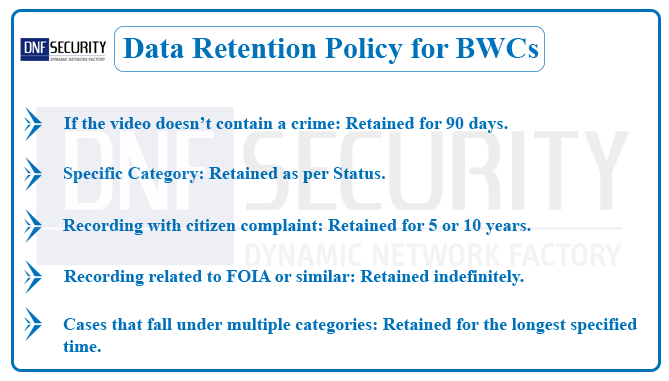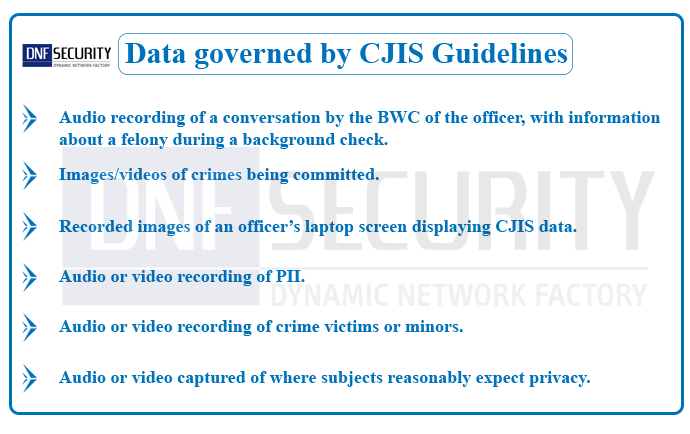Body worn camera video storage challenges and CJIS Compliance
4
OCTOBER 2017
As part of his commitment to build trust and transparency, the former President Barrack Obama’s government introduced Body Worn Cameras (BWCs) to the legal infrastructure. BWCs have been part of the system since June 29, 2015.
Metropolitan Police Department (MPD) IT departments noticed an immediate storage challenge with the video surveillance big data. Other challenges followed, demanding reliable solutions due to the sensitive nature of the data.
Data Implications of BWCs Video Surveillance Big Data
According to an estimate, 30 minutes of video data takes about 800 MB of storage space. An average shift comprises of 3 hours of video recorded data. This implies that an average shift generates approximately 5 Gegabytes of video data. This data can comprise of videos that have surveillance but do not contain any criminal offense or any relevant information; mixed with data that is actually relevant and has legal significance. Therefore, all of this compiled data cannot be immediately discarded. Regardless of the kind of data, it requires storage; depending on the category of data its retention policy may vary.
This compiled data requires a lot of storage space and this space simply cannot be contained in backup appliances or infrastructure. The best option that is being employed by MPD is cloud backup. Moving the data to cloud resolves storage issues and provides a scalable solution that efficiently allocates the tax payer’s money; instead of spending it unnecessarily.
Another data implication imposed by the BWC systems is of data transmission. BWC is a wireless technology; it requires latest innovations of technology such as IP video surveillance storage. Instead of using wires for data transmission, this solution transmits the recorded data wirelessly using a network.
Data Retention: Categorical classification of Recorded Data
The Body Worn Cameras Regulation and Reporting Requirements Act of 2015 Title III Subtitle Act of 2015 (Act 21-0148) compels MPD to publish BWC program data every six months. The first BWC report, published October 2015, also contained answers to a number of questions.
According to this report:

- If a video does not have any law enforcement purpose such as a recording of a crime, the report of a serious crime or of an arrest, it will be retained for 90 days.
- Specific types of recordings will be retained according to related status of limitations or long standing retention schedules for evidence.
- Video recordings that are the subject of a citizen complaint will be retained for five or ten years.
- Recordings that are related to litigation or requests under the FOIA (Freedom of Information Act), that haven’t been satisfied, will be retained indefinitely.
- For cases that fall under multiple categories; these cases will be retained for the longest specified time.
Verily, this retention can be done in tape storage or traditional storage solutions as well. However, it will cost additional tax payer money and that is not all. In accordance to a decision made in the New Mexico Supreme court, when a district attorney’s office opens, case police departments must have all evidence in play within 10 days or less. This includes all relevant information: documents, physical evidence, and images, audio and video recordings.
This imposes the challenge of managing data stored for 10 years or even more. Maintaining logs and lists of this data requires resources and if it’s being done on traditional infrastructure, it requires additional resources. However, data management is simplified with Artificial Intelligence solutions such as Amazon Macie, while Amazon’s Glacier storage tier is ideal for cost efficient data retention that spans over years.
CJIS Guidelines: What is CJIS?
Criminal Justice Information Services (CJIS) guidelines govern video and multimedia data thatcan potentially become law enforcement data. Some scenarios of this data are as follows:

- Officer radio transmission picked up by camera microphone, and the information is about a background check and comprises of felony data.
- The BWC captures images of a crime being committed.
- The BWC captures images of the officer’s laptop screen with CJIS data displayed.
- The BWC captures either audio or video of Personally Identifiable Information (PII). For instance, officer reviews a driver’s license and BWC captures an image of it.
- BWC captures images of crime victims or minors when officers are responding to an incident.
- Images and audio recorded by the BWC while operating in an area where subjects expect privacy – for instance, when officers respond to domestic violence incidents.
CJIS Compliance
There is no CJIS authorization body; consequently there can be no CJIS compliant organization. CJIS Security Policy and Requirements is a shared responsibility between FBI CJIS, CJIS Systems Agency (CSA), and the State Identification Bureaus (SIB) to regulate the lawful and appropriate protection and utilization of CJI (Criminal Justice Information).
Each law enforcement agency grants CJIS authorizations after analyzing solution according to their policies and risk acceptance standards. Authorizations from one state do not imply reciprocity with another state; it is standard practice to submit solutions for review with each agency authorizing official.
This makes CJIS compliance a difficult yet necessary endeavor. It is better to acquire the services of vendors that are already compliant. This information can be acquired from local law enforcement agencies.
DNF IP Surveillance Recording & Data Storage Services
Dynamic Network Factory (DNF) Security has been providing network video recording services since 1998. The innovative solutions of DNF security come in diverse sizes and are capable of addressing various challenges. Being an industry leader, DNF security is CJIS compliant and is capable of ensuring your sensitive video data remains secure using advanced encryption solutions.
Furthermore, DNF security’s appliances also come with cloud connect features. This enables you to easily move your data from the appliance directly to the cloud backup repository. This in turn speeds up data processing and improves overall proficiency.



